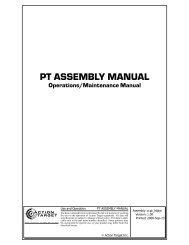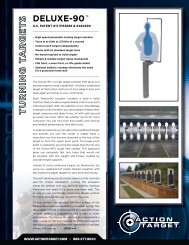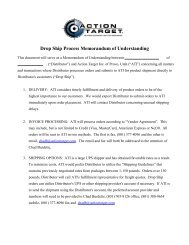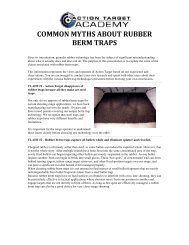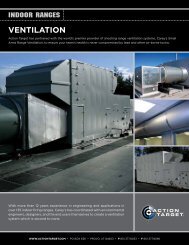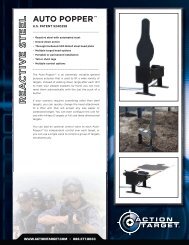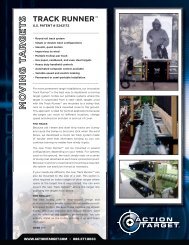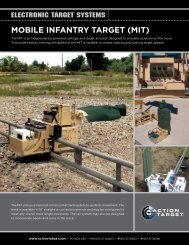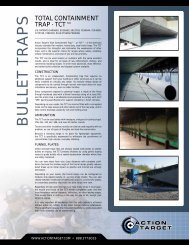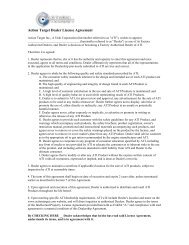BULLET TRAP COMPARISONS - Action Target
BULLET TRAP COMPARISONS - Action Target
BULLET TRAP COMPARISONS - Action Target
You also want an ePaper? Increase the reach of your titles
YUMPU automatically turns print PDFs into web optimized ePapers that Google loves.
<br />
Rubber Lamella Trap<br />
With this trap, tightly grouped rubber curtains or lamellas are hung from a support structure to create a<br />
bullet stopping barrier. As bullets pass through the layers of rubber strips, their energy is dissipated until<br />
they come to a stop. A steel plate is mounted at the back of the trap to block rounds that make it through the<br />
lamellas. Because rubber is destroyed every time you shoot into it, the rubber strips are quickly shredded<br />
under any kind of moderate to heavy use. One of the most quoted features of rubber traps is that bullets<br />
don't fragment on impact like they do on steel. This is true until bullets start impacting other bullets already<br />
embedded in the rubber. Regardless of the application, the use of a rubber bullet trap introduces a very real<br />
fire hazard that must be considered and dealt with appropriately<br />
The benefits of a lamella trap include its small floor space requirement, and the ability to capture some<br />
bullets whole.<br />
Weaknesses include high maintenance costs, fire hazard, messy appearance, and the restriction of low<br />
volume shooting only.<br />
Vertical Rubber Granule Trap<br />
Another European design uses a large steel chamber filled with chopped rubber and a penetrable rubber<br />
sheet across the front the keep the rubber granules in place.<br />
The trap works the same way a sand berm works, except the sand is replaced by granules of chopped<br />
rubber and the face of the trap is vertical. Like the rubber lamella trap, the front skin of the rubber granule<br />
trap is permanently damaged each time a bullet is fired into it.<br />
As larger and larger holes are created in the front skin, rubber granules can spill out and large bulges can<br />
develop as the structural integrity of the trap is compromised. Regular patching and repair is often required<br />
to keep the granules in the chamber.<br />
As the granules settle, areas of dangerously low density can form at the top of the trap causing rounds to<br />
pass through the rubber and escape out the back. To clean the trap, bullets must be mined and separated<br />
from the rubber then disposed of properly.<br />
The benefits of a vertical rubber granule trap include its small floor space requirement, the ability to<br />
capture some bullets whole, and reduced lead dust levels.<br />
Weaknesses include massive ongoing maintenance, service costs, fire hazard, and the restriction of low<br />
volume shooting only.



